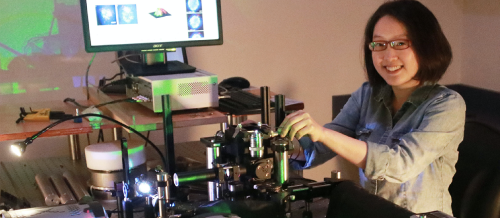
Assistant ProfessorT: 514-398-7985 | qian.liu3 [at] mcgill.ca (Email) | Parasitology Building, P-040 | Website |
Degrees
BSc (The Ocean University of China)
PhD (Washington State University)
Short Bio
After receiving her B.Sc. degree in biotechnology at the Ocean University of China in 2008, Vivian moved to Washington State University for her graduate study. She continued her Ph.D. study at the Center for Global Animal Health, where her projects focused on viral entry and membrane fusion. She did her postdoctoral training at the University of British Columbia from 2016 to 2020. She conducted research on virus assembly and budding, and obtained skills in developing super-resolution microscopes (single-molecule localization microscope and structure illuminated microscope) and image analysis.
Research Interests
Zoonotic diseases (zoonoses) are infectious diseases that originate from animal and infect human. Viral zoonoses comprise the majority of re-emerging and emerging infectious diseases and are widely considered to be one of the greatest challenges facing public health. It is more effective to protect human from viral zoonoses by eradicating the pathogens from animal reservoirs. My goal is to quantitatively understand the interplay between zoonotic viruses and their animal hosts during virus infection by using interdisciplinary approaches. The outcomes of my research will provide novel insights on the development of antiviral therapeutics against viral zoonoses.
Current Research
Virus biogenesis and infection: Viruses rely on their host for survival and replication. A virus must enter a cell, replicate, assemble, and release, and each stage involves specific virus-host interactions. Dr. Liu's study focuses on the role of the cellular membrane system in virus entry, replication and escape.
Virus and extracellular vesicles: Extracellular vesicles (EVs) are membrane-enclosed entities produced by cells at for cell-cell communication. They carry proteins and mRNAs, and release them to adjacent cells by direct membrane fusion. Viruses can use EVs to establish and maintain infections. Dr. Liu’s study focuses on how viruses use EVs for biogenesis and spread in the host.
Super-resolution microscopy: Super-resolution microscopy enables the analysis of viral and cellular processes at a resolution of 2-10-fold higher than conventional fluorescence microscopy. Dr. Liu’s research is powered by custom-built, state-of-art super-resolution microscopes.
Dr. Liu is looking for highly motivated graduate students. Please send your CV to qian.liu3 [at] mcgill.ca.
Publications
View current publications in Google Scholar
Select Publications
Q. Liu, L. Chen, H. C. Aguilar and K. C. Chou (2018) A stochastic assembly model for Nipah virus revealed by super-resolution microscopy Nat Commun 9: 3050
Q. Liu, J. A. Stone, B. Bradel-Tretheway, J. Dabundo, J. A. Benavides Montano, J. Santos-Montanez, S. B. Biering, A. V. Nicola, R. M. Iorio, X. Lu and H. C. Aguilar (2013) Unraveling a three-step spatiotemporal mechanism of triggering of receptor-induced Nipah virus fusion and cell entry PLoS Pathog 9: e1003770
